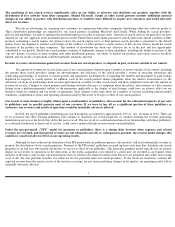Incredimail 2014 Annual Report Download - page 21
Download and view the complete annual report
Please find page 21 of the 2014 Incredimail annual report below. You can navigate through the pages in the report by either clicking on the pages listed below, or by using the keyword search tool below to find specific information within the annual report.
If we fail to detect click fraud or other invalid clicks on ads, we could lose the confidence of our advertisers of mobile applications, which
would cause our business to suffer.
Our business relies on delivering positive results to our advertisers of mobile applications. We are exposed to the risk of fraudulent and
other invalid clicks or conversions that advertisers may perceive as undesirable. Because of their smaller sizes as compared to personal
computers, mobile device usage could result in a higher rate of accidental or otherwise inadvertent clicks by a user. Invalid clicks could also
result from click fraud, where ads are being clicked, by automatic or other malicious means for reasons other than to access the underlying
content of the ads. If fraudulent or other malicious activity is perpetrated by others, and we are unable to detect and prevent it, the affected
advertisers may experience or perceive a reduced return on their investment. High levels of invalid click activity could lead to dissatisfaction
with our advertising services, refusals to pay, refund demands or withdrawal of future business. Any of these occurrences could damage our
brand and lead to a loss of our revenue.
Risks Related to Our Intellectual Property
Unlawful copying of our products or other third party violations of existing legal protections or reductions in the legal protection for
intellectual property rights of software developers could adversely affect our distribution and revenue.
The software products that we license for use incorporate a technology that reduces the ability of third parties to copy the software
without having paid for the right to use the software. Unlicensed copying and use of software and intellectual property rights by third parties
could lead to a loss of potential users and revenues, which could be more significant in countries where laws are less protective of intellectual
property rights. Continued educational and enforcement efforts by governmental authorities may not adequately address this problem, and
further deterioration in compliance with existing legal protections or reductions in the legal protection for intellectual property rights of software
developers could adversely affect our revenue.
Additionally, no assurances can be given that any of the patent applications that we have filed will result in a patent being issued, or that
any existing or future patents will afford adequate protection against competitors and similar technologies.
We use certain "open source" software tools that may be subject to intellectual property infringement claims or that may subject our
derivative works or products to unintended consequences, possibly impairing our product development plans, interfering with our
ability to support our clients or requiring us to allow access to the source code of our products or necessitating that we pay licensing
fees.
Certain of our software products contain a limited amount of open source code and we may use more open source code in the future. In
addition, certain third party software that we embed in our products contains open source code. Open source code is code that is covered by a
license agreement that permits the user to liberally use, copy, modify and distribute the software without cost, provided that users and modifiers
abide by certain licensing requirements. The original developers of the open source code provide no warranties on such code.
As a result of the use of open source software, we could be subject to suits by parties claiming ownership of what they believe to be
their proprietary code or we may incur expenses in defending claims alleging non-
compliance with certain open source code license terms. In
addition, third party licensors do not provide intellectual property protection with respect to the open source components of their products, and
we may be unable to be indemnified by such third party licensors in the event that we or our customers are held liable in respect of the open
source software contained in such third party software. If we are not successful in defending against any such claims that may arise, we may be
subject to injunctions and/or monetary damages or be required to remove the open source code from our products. Such events could disrupt our
operations and the sales of our products, which would negatively impact our revenues and cash flow.
Moreover, under certain conditions, the use of open source code to create derivative code may obligate us to make the resulting
derivative code available to others at no cost. The circumstances under which our use of open source code would compel us to offer derivative
code at no cost are subject to varying interpretations. If we are required to publicly disclose the source code for such derivative products or to
license our derivative products that use an open source license, our previously proprietary software products may be available to others without
charge. If this happens, our customers and our competitors may have access to our products without cost to them which could harm our business.
Certain open source licenses require as a condition to use, modification and/or distribution of such open source that proprietary software
incorporated into, derived from or distributed with such open source be disclosed or distributed in source code form, be licensed for the purpose
of making derivative works, or be redistributable at no charge. The foregoing may under certain conditions be interpreted to apply to our
software, depending upon the use of the open source and the interpretation of the applicable open source licenses.
17
























